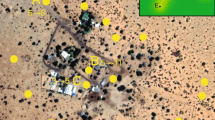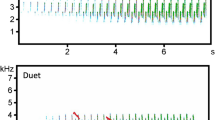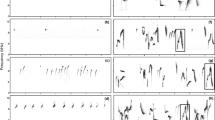Abstract
Studying the structure and patterns of vocalizations in primates is important to understand their evolution, responses to changing environments, and social behavior, and to design efficient vocalization-based survey techniques. Gibbons (Hylobatidae) are small arboreal apes known for their stereotyped songs. Data on their vocalization patterns remain limited, especially for crested gibbons (Nomascus spp.). We recorded songs of white-cheeked gibbons (Nomascus sp.) heard from listening posts at a site in Nakai–Nam Theun National Protected Area, central-eastern Laos, during a cold dry and a warm dry season, from November 2013 to May 2014, along with weather data. Males typically initiated the duet songs at a mean time of 06:14 h. Duet song bouts lasted a mean of 16 min. Song bout length was relatively constant throughout the study but decreased with the occurrence of wind. On a given day, the first male song started at a mean of 12 min before sunrise and all songs ceased at a mean of 13 min after sunrise. The start time of the first song relative to sunrise did not differ significantly between the two seasons but we found a significant negative relationship between the start time of the first song and both time of sunrise and temperature. The mean number of song bouts heard was significantly larger during the cold dry season than the warm dry season, and we found a significant negative relationship between the number of song bouts heard and temperature. Song rates also increased during days with no rain relative to rainy days. Our findings provide a preliminary understanding of song patterns in Nomascus spp. and can aid the planning and interpretation of surveys that rely on documenting their calls.




Similar content being viewed by others
References
Bartlett, T. Q. (2009). Territoriality and intergroup encounters. In T. Q. Bartlett (Ed.), The gibbons of Khao Yai: Seasonal variation in behaviour and ecology (pp. 103–119). Boston: Allyn & Bacon.
Brockelman, W., & Ali, R. (1987). Methods of surveying and sampling forest primate populations. In C. W. Marsh & R. A. Mittermeier (Eds.), Primate conservation in the tropical rain forest (pp. 23–62). New York: Alan R. Liss.
Brockelman, W., & Srikosamatara, S. (1993). Estimation of density of gibbon groups by use of loud songs. American Journal of Primatology, 29, 93–108.
Brown, C. H., Gomez, R., & Waser, P. M. (1995). Old world monkey vocalizations: adaptations to the local habitat? Animal Behaviour, 50, 945–961.
Cheyne, S. M. (2008). Effects of meteorology, astronomical variables, location and human disturbance on the singing apes: Hylobates albibarbis. American Journal of Primatology, 70, 386–392.
Clarke, E., Reichard, U. H., & Zuberbu, K. (2006). The syntax and meaning of wild gibbon songs. PloS one, e73.
Coudrat, C. N. Z., & Nanthavong, C. (2014). Gibbon survey and taxonomical status in Nakai-Nam Theun National Protected Area, Laos reveals one of the largest remaining populations of white-cheeked gibbons: Implications for their long-term conservation [Abstract]. Hanoi, Vietnam: XXVIth International Primatological Society Congress, August 11–16, 2014.
Cowlishaw, G. U. Y. (1992). Song function in gibbons. Behaviour, 121, 131–153.
Dallmann, R., & Geissmann, T. (2001). Different levels of variability in the female song of silvery gibbons (Hylobates moloch). Behaviour, 138, 629–648.
Dallmann, R., & Geissmann, T. (2009). Individual and geographical variability in the songs of wild silvery gibbons (Hylobates moloch) on Java, Indonesia. In S. Lappan & D. Whittaker (Eds.), The gibbons: New perspectives on small ape socioecology and population biology (pp. 51–72). New York: Springer Science+Business Media.
Dooley, H. M., Judge, D. S., & Schmitt, L. H. (2013). Singing by male and female Kloss gibbons (Hylobates klossii) in the Peleonan Forest, Siberut Island, Indonesia. Primates, 54, 39–48.
Duckworth, J. W. (2008). Preliminary gibbon status review for Lao PDR 2008. Vientiane, Laos: Fauna & Flora International.
Duckworth, J. W., Robichaud, W. G., & Eve, R. (2005). Observations of birds and large mammals in Phongsaly province, Lao PDR, with particular reference to Phou Dendin National Protected Area. Vientiane, Laos: WWF-Laos.
Duckworth, J. W., Timmins, R. J., Anderson, G. Q. A., Thewlis, R. M., Nemeth, E., Evans, T. D., Dvorak, M., & Cozza, K. E. A. (1995). Notes on the status and conservation of the gibbon Hylobates (Nomascus) gabriellae in Laos. Tropical Biodiversity 3, 15–27.
Erkert, H. G. (2003). Chronobiological aspects of primate research. In J. M. Setchell & D. J. Curtis (Eds.), Field and laboratory methods in primatology (pp. 252–270). Cambridge, UK: Cambridge University Press.
Fan, P.-F., Ni, Q.-Y., Sun, G.-Z., Huang, B., & Jiang, X.-L. (2008). Seasonal variations in the activity budget of Nomascus concolor jingdongensis at Mt. Wuliang, central Yunnan, China: Effects of diet and temperature. International Journal of Primatology, 29, 1047–1057.
Fan, P., Xiao, W. E. N., Huo, S., & Jiang, X.-L. (2009). Singing behavior and singing functions of black-crested gibbons (Nomascus concolor jingdongensis) at Mt. Wuliang, Central Yunnan, China. American Journal of Primatology, 71(7), 539–547.
Geissmann, T. (1993). Evolution of communication in gibbons (Hylobatidae). Doctoral dissertation, Zurich University, Switzerland.
Geissmann, T. (2002). Duet-splitting and the evolution of gibbon songs. Biological Reviews, 77, 57–76.
Geissmann, T., & Nijman, V. (2006). Calling in wild silvery gibbons (Hylobates moloch) in Java (Indonesia): Behavior, phylogeny, and conservation. American Journal of Primatology, 68, 1–19.
Haimoff, E. H. (1984). The organization of song in the Hainan black gibbon (Hylobates concolor hainanus). Primates, 25, 225–235.
Harrison, M. E., Cheyne, S. M., Sulistiyanto, Y., & Rieley, J. O. (2007). Biological effects of smoke from dry-season fires in non-burnt areas of the Sabangau peat swamp forest, Central Kalimantan, Indonesia. In J. O. Rieley, C. J. Banks, & G. Radjaguk (Eds.), Carbon-climate-human interaction on Tropical Peatland: Proceedings of the international symposium and workshop on Tropical Peatland, Yogyakarta, August 27–29, 2007 (pp. 1–5). Gadjah Mada University, Indonesia and University of Leicester, UK: EU CARBOPEAT and RESTOPEAT Partnership.
Heller, R., Sander, A. F., Wang, C. W., Usman, F., & Dabelsteen, T. (2010). Macrogeographical variability in the great call of Hylobates agilis: Assessing the applicability of vocal analysis in studies of fine-scale taxonomy of gibbons. American Journal of Primatology, 72, 142–151.
Hijmans, R. J., Cameron, S. E., Parra, J. L., Jones, P. G., & Jarvis, A. (2005). Very high resolution interpolated climate surfaces for global land areas. International Journal of Climatology, 25, 1965–1978.
Johns, A. D. (1985). Behavioral responses of two Malaysian primates (Hylobates lar and Presbytis melalophos) to selective logging: Vocal behavior, territoriality, and nonemigration. International Journal of Primatology, 6, 423–433.
Johnson, A., Singh, S., Duangdala, M., Hedemark, M. (2005). The western black crested gibbon Nomascus concolor in Laos: new records and conservation status. Oryx 39, 311–317.
Keith, S. A., Waller, M. S., & Geissmann, T. (2009). Vocal diversity of Kloss’s gibbons (Hylobates klossii) in the Mentawai Islands, Indonesia. In S. Lappan & D. Whittaker (Eds.), The gibbons: New perspectives on small ape socioecology and population biology (pp. 91–110). New York: Springer Science+Business Media.
Konrad, R. (2004). Vocal diversity and taxonomy of the crested gibbons (genus Nomascus) in Cambodia. PhD dissertation, University of Zurich, Switzerland.
Konrad, R., & Geissmann, T. (2006). Vocal diversity and taxonomy of Nomascus in Cambodia. International Journal of Primatology, 27, 713–745.
Lan, D.-Y. (1993). Feeding and vocal behaviours of black gibbons (Hylobates concolor) in Yunnan: A preliminary study. Folia Primatologica, 60, 94–105.
Larom, D., Garstang, M., Payne, K., & Raspet, R. (1997). The influence of surface atmospheric conditions on the range and area reached by animal vocalisations. The Journal of Experimental Biology, 200, 421–431.
Marshall, J. T., & Marshall, E. R. (1976). Gibbons and their territorial songs. Science, 193(4249), 235–237.
Melfi, V. A. (2012). Gibbons: Probably the most endangered primates in the world. International Zoo Yearbook, 46, 239–240.
Mitani, J. C. (1988). Male gibbon (Hylobates agilis) singing behavior: Natural history, song variations and function. Ethology, 79, 177–194.
Morrill, R. J., Thomas, A. W., Schiel, N., Souto, A., & Miller, C. T. (2013). The effect of habitat acoustics on common marmoset vocal signal transmission. American Journal of Primatology, 75, 904–916.
Pollock, J. I. (1986). The song of the Indris (Indri indri; Primates: Lemuroidea): Natural history, form, and function. International Journal of Primatology 7, 225–264.
Rawson, B. (2004). Vocalisation patterns in the yellow-cheeked crested gibbon (Nomascus gabriellae). In T. Nadler, U. Streicher, & H. T. Long (Eds.), Conservation of primates in Vietnam (pp. 130–136). Hanoi, Vietnam: Frankfurt Zoological Society; Endangered Primate Rescue Center.
Rawson, B. M., Clements, T., & Nut Meng Hor. (2009). Status and conservation of yellow-cheeked crested gibbons (Nomascus gabriellae) in the Seima Biodiversity Conservation Area, Mondulkiri Province, Cambodia. In S. Lappan & D. Whittaker (Eds.), The gibbons: New perspectives on small ape socioecology and population biology (pp. 387–408). New York: Springer Science+Business Media.
Rawson, B. M., Insua-cao, P., Ha, N. M., Thinh, V. N., Hoang, D. M., Mahood, S., Geissmann, T., & Roos, C. (2011). The conservation status of gibbons in Vietnam. Hanoi, Vietnam: Fauna & Flora International and Conservation International.
Riley, E. P., Mackinnon, K. C., Fernandez-duque, E., Setchell, J. M., & Garber, P. A. (2014). Code of best practices for field primatology. International Primatological Society and American Society of Primatologists Steering Committee.
Robichaud, W., Sinclair, A., Odarkor-Lanquaye, N., & Klinkenberg, B. (2009). Stable forest cover under increasing populations of swidden cultivators in central Laos: The roles of intrinsic culture and extrinsic wildlife trade. Ecology and Society, 14, 33–60.
Srikosamatara, S., & Brockelman, W. Y. (1983). Patterns of territorial vocalization in the pileated gibbon (Hylobates pileatus). In P. K. Seth (Ed.), Perspectives in primate biology (pp. 19–22). New Delhi, India: T.T.P.P. Publishers.
Tenaza, R. (1976). Songs, choruses and countersinging of Kloss’ gibbons (Hylobates klossii) in Siberut Island, Indonesia. Zeitschrift für Tierpsychologie, 40, 37–52.
Thinh, V. N., Mootnick, A. R., Geissmann, T., Li, M., Ziegler, T., Agil, M., Moisson, P., Nadler, T., Walter, L., & Roos, C. (2010a). Mitochondrial evidence for multiple radiations in the evolutionary history of small apes. BMC Evolutionary Biology, 10, 74–87.
Thinh, V. N., Rawson, B., Hallam, C., Kenyon, M., Nadler, T., Walter, L., & Roos, C. (2010b). Phylogeny and distribution of crested gibbons (genus Nomascus) based on mitochondrial cytochrome b gene sequence data. American Journal of Primatology, 72, 1047–1054.
Thinh, V. N., Hallam, C., Roos, C., & Hammerschmidt, K. (2011). Concordance between vocal and genetic diversity in crested gibbons. BMC Evolutionary Biology, 11, 36–44.
Timmins, R. J., & Evans, T. D. (1996). Wildlife and habitat survey of the Nakai-Nam Theun National Biodiversity Conservation Area. Vientiane, Lao PDR: Wildlife Conservation Society.
Traeholt, C., Bonthoeun, R., Virak, C., Samuth, M., & Vutthin, S. (2006). Song activity of the Pileated gibbon, Hylobates pileatus, in Cambodia. Primate Conservation, 21, 139–144.
Van Belle, S., Estrada, A., & Garber, P. A. (2013). Spatial and diurnal distribution of loud calling in black howlers (Alouatta pigra). International Journal of Primatology, 34, 1209–1224.
Whitten, A. J. (1982). The ecology of singing in Kloss gibbons (Hylobates klossii) on Siberut Island, Indonesia. International Journal of Primatology, 3, 33–51.
Acknowledgments
Permission to conduct this research was provided by the Ministry of Natural Resources and Environment of Lao PDR (authorization letter No. 5707, dated August 29, 2013) and the Nam Theun 2 Watershed Management and Protection Authority. Special thanks go to the field assistants from Ban Navang and Ban Nahao. Thank you to Project Anoulak’s team for the support to make this gibbon project possible. Funding for this study was provided by Parc Animalier d’Auvergne/La Passerelle Association (France), Minnesota Zoo (USA), Mulhouse Zoo (France), Zoologische Gesellschaft Für Arten Und Populationsschutz e. V. (ZGAP) (Germany), Idea Wild (USA), Le Conservatoire pour la Protection des Primates/La Vallée des Singes (France), Primate Conservation Inc. (USA), Apenheul Primate Park (The Netherlands), American Society of Primatology (USA), Association Française des Parcs Zoologiques (France), and Suranaree University of Technology (Thailand). We are grateful to T. Q. Bartlett, W. Brockelman, W. J. Duckworth, anonymous reviewers, and the journal editor for their comments on earlier drafts, which substantially improved the manuscript.
Author information
Authors and Affiliations
Corresponding author
Rights and permissions
About this article
Cite this article
Coudrat, C.N.Z., Nanthavong, C., Ngoprasert, D. et al. Singing Patterns of White-Cheeked Gibbons (Nomascus sp.) in the Annamite Mountains of Laos. Int J Primatol 36, 691–706 (2015). https://doi.org/10.1007/s10764-015-9849-x
Received:
Accepted:
Published:
Issue Date:
DOI: https://doi.org/10.1007/s10764-015-9849-x




